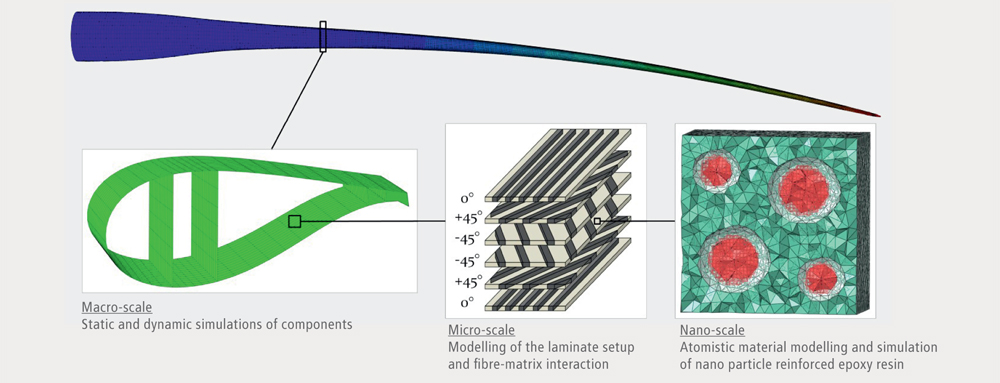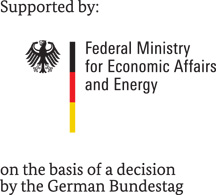
The economical success in establishing renewable energies in Germany and other countries heavily depends on the efficiency of the systems used for its generation. Therefore, increasing efficiency of the present systems is a major topic in international research. Considering offshore wind energy, which is and will be one of the most important sources for renewable energy, this increase of efficiency means to enlarge the length of the wind turbine rotor blades. Although today’s blades can hold lengths up to 85m, the established materials, usually glass fibre reinforced polymers (GFRP), encounter their constructive limits.
One of the main problems concerning offshore rotor blades is the blade stiffness, which needs to be increased with increasing length. A large blade of insufficiently low stiffness may hit the tower under extreme loading conditions. A total loss of the turbine would be the result. A sufficient stiffness of future blades with today’s established materials would either lead to very high weight in case of GFRP, or to inacceptable high costs in case of carbon fibre reinforced polymers (CFRP).
A second issue is the high fatigue resistance of the applied material, which is needed to withstand up to 100 million load cycles during a wind turbines lifetime of about 20 years. If the fatigue resistance of the materials applied is too low, cracks may grow within the blade, yielding its total loss at worst. The fact that future blades with lengths over 90m will have to withstand fatigue loadings of even higher amplitude than the largest blades of the present explains the urgent need for materials with an extremely high fatigue resistance. The application of traditional materials like GFRP or CFRP would again yield too heavy and too cost intensive constructions, respectively. Within the LENAH project innovative material concepts are to be investigated, which offer the above characteristics. To do so, the project takes into account two important fields of material re-search: hybrid and nanomodified materials.
Nanomodified polymers are created by mixing nano particles with an average size of about 50 nm and conventional polymers. The interaction between the polymer molecules and the nano particles, which have a huge cumulative surface (‘nano effect’), lead to improved mechanical properties of the material. This beneficial effect can be applied for fibre reinforced polymers, as well as for pure adhesive polymers. Within the LENAH project nano particle reinforced polymers are investigated by experimental tests and multi scale finite element simulations. First of all, atomistic simulations on nano-scale are performed to derive the unknown material properties, followed by micro-scale simulations, as well as component simulations on the macro-scale (see picture below). The major aim is to understand and characterize the influence of nanomodifications on the material properties. With the knowledge gained materials can be designed that merge the positive characteristics of the base materials and allow a more efficient design of wind turbine rotor blades.
A similar idea holds for hybrid materials, where the ideal aim is to create a material which holds the advantages of all the base materials. Within the LENAH project hybrid laminates made from GFRP and steel as well as GFRP and CFRP will be investigated. Here, not only the optimization of the resulting material properties is considered, but also the manufacturability and the profitability. GFRP-steel laminates are to be used within the load introduction area, where the blade is bolted to the hub of the turbine. Due to the bolt holes local stress concentrations occur, which can damage the brittle GFRP massively. Local application of much stiffer steel foils in between the GFRP layers results in a smooth introduction of the loads into the laminate. Once a certain distance from the in-troduction area is ensured, the metal foils are substituted by regular GFRP layers. This procedure yields a higher embedding strength in combination with a sufficient fatigue resistance within the load introduction area. The application of GFRP-CFRP laminates is an efficient method to locally increase the stiffness of the load carrying parts of the blade. These parts are in particular the girths of the bendingbeams, which are hidden under the blade skin and generate the overall stiffness of the blade. The connection between the girths may then be made from much cheaper GFRP, since these regions add no significant bending stiffness to the blade.

